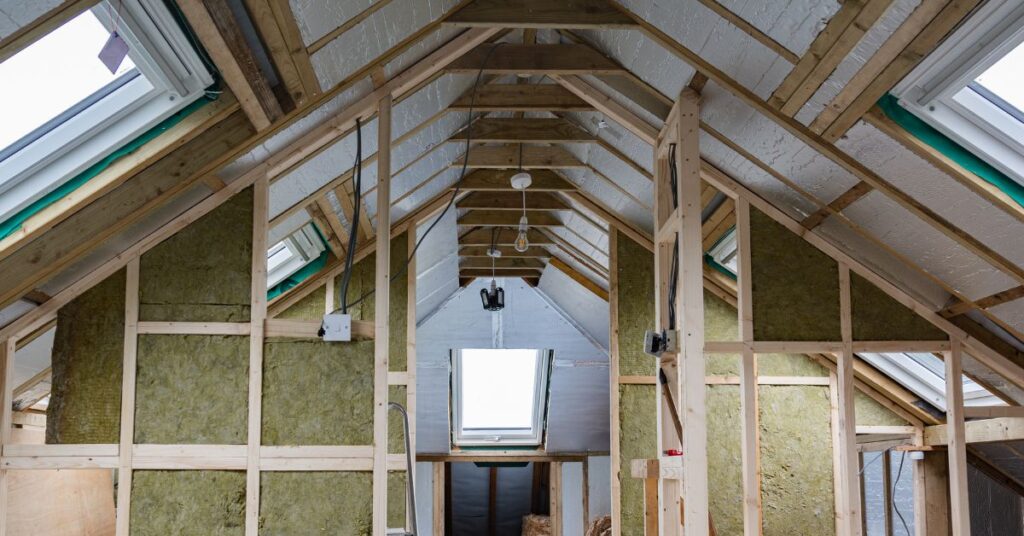The UK sees loft conversions as one of its top home improvement choices because they allow homeowners to unlock their property’s full potential. Understanding the legal requirements of your project is essential to avoid financial setbacks during a loft conversion. This manual explores the potential legal problems of loft conversions while offering practical advice to help you steer clear of them.
Understanding Planning Permission and Permitted Development
Many loft conversions qualify under Permitted Development rights, which permits homeowners to carry out the work without obtaining formal planning permission. However, certain conditions must be met:
- Volume Allowance: Terraced house extensions cannot surpass 40 cubic meters, while detached and semi-detached house extensions must remain below 50 cubic meters.
- Height Restrictions: The roof’s highest point determines the extension’s maximum height.
- Materials: The building materials selected should match the appearance of the existing house.
- Windows: Any side-facing windows should have obscure glazing, and openings must maintain a minimum height of 1.7 meters above floor level.
Please understand that PD rights exclude certain types of properties.
Ideal Home
- Flats and Maisonettes: All loft conversions on these properties require planning permission before execution.
- Listed Buildings: Any alterations require Listed Building Consent.
- Conservation Areas: Extra limitations might be required when working within conservation areas, and planning permission usually becomes necessary.
- GreenMatch.co.uk
If you do not secure the required permissions, enforcement actions can occur, including costly and time-consuming orders to dismantle completed work.
Building Regulations Compliance
All loft conversions require adherence to Building Regulations for safety and structural integrity regardless of planning permission status. Key areas include:
Which?
- Structural Stability: It is essential to verify that the current building structure can handle additional weight from the new construction.
- Fire Safety: Implementing appropriate fire-resistant materials and escape routes.
- Insulation: Meeting standards for thermal and sound insulation.
- Staircase Design: The new space requires a staircase design that provides safe and accessible access.
- Ventilation: Airflow regulation protects against condensation buildup while keeping air quality optimal.
- staac.co.uk
- abbeylofts.net
Not complying with regulations can trigger legal action and potentially decrease the property’s market value.
Party Wall Agreements
The Party Wall Act 1996 necessitates you to provide a Party Wall Notice before beginning work on a shared wall during a loft conversion—the Party Wall, etc. Act 1996 mandates the issuance of a Party Wall Notice before starting work. A minimum of two months before beginning work, you have to deliver this notice.
If your neighbour consents, work can proceed. A Party Wall Agreement becomes necessary if neighbourly consent is not received and surveyors frequently assist in creating it. Failure to follow this procedure can result in legal battles and possible court orders.
fmb.org.uk
+2
abbeylofts.net
+2
Which?
+2
Which?
Leasehold Considerations
Loft spaces may not fall under leasehold property leases, which require freeholder permission for any conversion work. Your lease may include the loft space yet contain covenants that limit alterations. Examine your lease agreement thoroughly and seek advice from the freeholder before moving forward.
Conservation Areas and Listed Buildings
Properties located within conservation areas or those classified as listed buildings must adhere to additional regulatory restrictions.
Ideal Home
- Conservation Areas: When you plan to modify how your property looks from the outside, you typically need planning permission.
- Listed Buildings: Consent must be secured for any modifications performed inside or outside the building.
Without proper consent, individuals may face criminal prosecution and significant monetary penalties.
Structural Integrity and Load-Bearing Walls
Loft conversions increase property weight, which means the building structure must be verified for load-bearing capacity. A structural engineer should assess the following:
- Floor Joists: New joists typically need installation to handle the extra weight.
- Load-Bearing Walls: Modifications may necessitate additional support or reinforcement.
- Foundations: In rare cases, foundations may need strengthening.
- touchstonelofts.co.uk
- +1
- Which?
- +1
Failure to perform structural assessments creates significant safety risks and potential legal consequences.
Fire Safety Regulations
Fire safety remains the most crucial consideration when converting lofts. Key requirements include:
GreenMatch.co.uk
- Escape Routes: The escape route from the loft to the ground floor must meet safety and accessibility standards.
- Fire Doors: Fire-resistant doors rated for 30 minutes must be installed in all habitable rooms which lead toward the escape route.
- Smoke Alarms: Smoke alarms need to communicate with each other and be placed on all building levels.
- Fire-Resistant Materials: Utilize materials that can endure fire exposure for a designated period.
- GreenMatch.co.uk +1
- Clapham Construction Service +1
- GreenMatch.co.uk +2
- touchstonelofts.co.uk +2
- Clapham Construction Service +2
Following these regulations fulfils legal obligations and protects the safety of building occupants.
Access and Staircase Regulations
The law necessitates proper access pathways to the loft space. Building Regulations stipulate:
- Staircase Design: Building regulations require stairs to maintain a maximum angle of 42 degrees and a minimum headroom of 2 meters.
- Space-Saving Stairs: Spiral staircases are acceptable alternatives to traditional stairs if they fulfil particular standards.
- Retractable Ladders: Generally not acceptable for habitable rooms.
- GreenMatch.co.uk
Lack of proper access leads to legal violations and hazardous conditions.
Insulation and Energy Efficiency
Loft conversions must meet energy efficiency standards:
Clapham Construction Service
- Thermal Insulation: Walls, floors, and ceilings must have sufficient insulation to reach required U-value standards.
- Ventilation: Airflow regulation prevents condensation buildup while keeping air quality optimal.
- Glazing: Energy efficiency standards require windows to have double or triple glazing.
- Clapham Construction Service
- abbeylofts.net
Properties that don’t meet compliance standards will face increased energy costs, potentially negatively impacting their Energy Performance Certificate (EPC) rating.
Electrical and Plumbing Compliance
Building Regulations set the standards for all electrical and plumbing work.
- Electrical Work: A qualified electrician needs to perform electrical work in Compliance with Part P Building Regulations.
- Plumbing: New bathrooms and water installations require adherence to established regulations and standards.
- Certification: Appropriate documents confirming completion must be gathered and stored following project completion.
Not following regulations creates safety risks and makes selling the property more difficult.
Impact on Property Value and Insurance
Although a properly conducted loft conversion could boost property value, it will reduce property value if legal requirements are not followed.
- Property Value: Potential buyers may avoid homes with unauthorized or poorly executed conversions.
- Insurance: If your property conversion work violates building regulations, your home insurance coverage will become void, and you will be left unprotected.
- Mortgage Issues: Financial institutions might hesitate to approve mortgage loans for homes with unauthorized conversion work.
Common Mistakes and How to Avoid Them
This section outlines common mistakes homeowners make when converting lofts and provides tips to prevent them.
Hiring Unqualified Contractors: Select contractors with proper qualifications and experience from recognized UK trade organizations like FMB or TrustMark wherever possible.
No Written Contracts: Verbal agreements may create misunderstandings, which can escalate into disputes. Ensure that your project documentation includes detailed contracts that define the scope of work, payment schedules, project timelines, and penalty clauses.
Skipping Professional Surveys: Conducting structural, roof, and insulation surveys before starting work helps identify concealed problems, which reduces longer-term expenses.
Not Informing the Council When Required: Local planning authorities require notification for permitted development projects involving roofline changes or dormer additions.
Proceeding Without Certificates: Property sales and refinancing options become unavailable without electrical (Part P), plumbing (WRAS), or Building Control completion certificates.
Case Studies: Real Legal Pitfalls Faced by UK Homeowners
Case Study 1: Cambridge homeowner modified their building in a conservation area without a planning permit.
The Cambridge homeowner who installed a rear dormer on his property was unaware it was located in a conservation area. The construction project broke local planning regulations, prompting an enforcement notice requiring the dormer’s removal for £15,000. Lesson: Review local planning regulations before starting work in conservation areas.
Case Study 2: A London leaseholder carried out a loft conversion without obtaining Permission from the freeholder.
A North London flat owner made a loft conversion, believing that the space was included in their leasehold agreement. The property owner sued because they believed the communal space was used without proper authorization. The loft needed restoration to its initial condition. Legal and construction costs exceeded £25,000. Lesson: Leaseholders must get written consent.
Case Study 3: Party Wall Dispute Turns Legal (Manchester)
A semi-detached homeowner constructed a dormer which impacted the shared chimney breast without providing a Party Wall Notice. The neighbour obtained a legal order to pause construction work. Legal action and building restoration led to a £12,000 cost increase. Lesson: Stay compliant with the Party Wall Act by properly informing your neighbours.
Understanding Legal Inspections and Sign-Off Procedures
Throughout your loft conversion Building Control will conduct multiple inspections at different stages.
Building Control performs structural inspections after installing steel beams or new joists.
Fire safety compliance checks involve the examination of doors, alarms and escape routes.
A thermal insulation review evaluates the insulation effectiveness of both roofs and walls.
Final inspection includes verification of total compliance standards followed by issuance of Completion Certificate.
Your contractor and local authority must pre-schedule all inspection visits. A property cannot be sold easily if it lacks a Completion Certificate.
Legal protection strategies for your loft conversion
Hire a Chartered Architect: Architects registered with RIBA know UK regulations, which enables them to produce plans that adhere to local planning and building requirements.
Get a Lawful Development Certificate (LDC): An LDC verifies the legality of your build at the time, even if planning permission wasn’t required. It helps sell or remortgage.
Use a Building Control Approved Inspector: Your local authority or a private inspector can check compliance, but both need to be registered with the CICAIR (Construction Industry Council Approved Inspectors Register).
Document Everything: Keep a record of all communications with your contractor, Building Control authorities, neighbours and local planning department, including email exchanges and financial documents.
Inform Your Mortgage Lender: When a loft conversion affects your home’s monetary worth or alters bedroom count, you must update your lender regarding insurance and finance requirements.
Future-Proofing Your Loft Legally
Anticipating future requirements will enable you to maintain compliance throughout the years.
Future Resale: Your loft conversion must adhere to current regulations because prospective buyers will probably ask for these documents when purchasing your property.
Rental Use: When you intend to lease the converted space (for example, as a studio or Airbnb), then it must meet specific housing safety requirements and local council regulations. A converted space used as a studio or Airbnb needs to follow extra housing safety rules and local council regulations.
Change of Use: When you transform the loft into a standalone living space (such as a granny flat or annexe), you will need planning Permission and must account for council tax implications. Planning permission requirements and council tax implications must be considered when converting a loft into a separate dwelling, such as a granny flat or annexe.
Title Deed Updates: Leasehold property owners who create new paths or rearrange interior spaces may need to revise their title deeds or lease plans.
Expert Quotes and Industry Advice
In our practice, more than fifty per cent of planning enforcement cases stem from people under the misconception that permitted development eliminates the need for rules.
— Sarah Grant, Chartered Planning Consultant (RTPI)
Avoid finding out you have violated Building Regulations when you reach the halfway point of your construction project. A qualified team working with you from the beginning of your project will protect you from unnecessary expenses and delays.
— James Willis, Structural Engineer, CEng MICE
Homes in conservation zones may incur fines if Velux windows are installed at incorrect locations. Consult with your council’s heritage officer beforehand.”
Heritage Planner Emma Jarvis works for the South Oxfordshire District Council.
Frequently Asked Questions (FAQs)
Q1. Can we carry out a loft conversion under Permitted Development rules in the UK during 2025?
You are eligible for a loft conversion under Permitted Development if your property satisfies specific requirements, such as not being in a conservation area and staying within the cubic volume limits.
Q2. Planning Permission concerns your extension’s aesthetics and environmental impact while Building Regulations address safety standards and structural integrity.
Planning Permission addresses how your extension looks and affects its environment. Building Regulations address structural safety and requirements for fire protection, insulation standards and accessibility features.
Q3. Local authorities have the power to issue fines for unauthorized loft conversions.
Local authorities have the power to issue enforcement notices, stop-work orders, and levy fines. Undoing your work may become necessary.
Q4. To determine if your loft space is covered under your lease, you should seek professional legal advice to examine your leasehold documentation and property plan.
Get a solicitor to analyze your leasehold agreement and title plan.
Q5. Is a Party Wall Agreement always needed?
A Party Wall Agreement becomes necessary when your work impacts a shared wall by installing beams or raising walls. A formal notice is required by law.

Sunny Saini is a certified heating engineer with over 15 years of experience in maintaining and repairing boilers. He specializes in diagnosing complex boiler issues and providing reliable solutions to ensure homeowners stay warm and comfortable throughout the year.





![]=](https://localboiler.co.uk/wp-content/uploads/2024/05/Untitled-design-96-300x300.jpg)